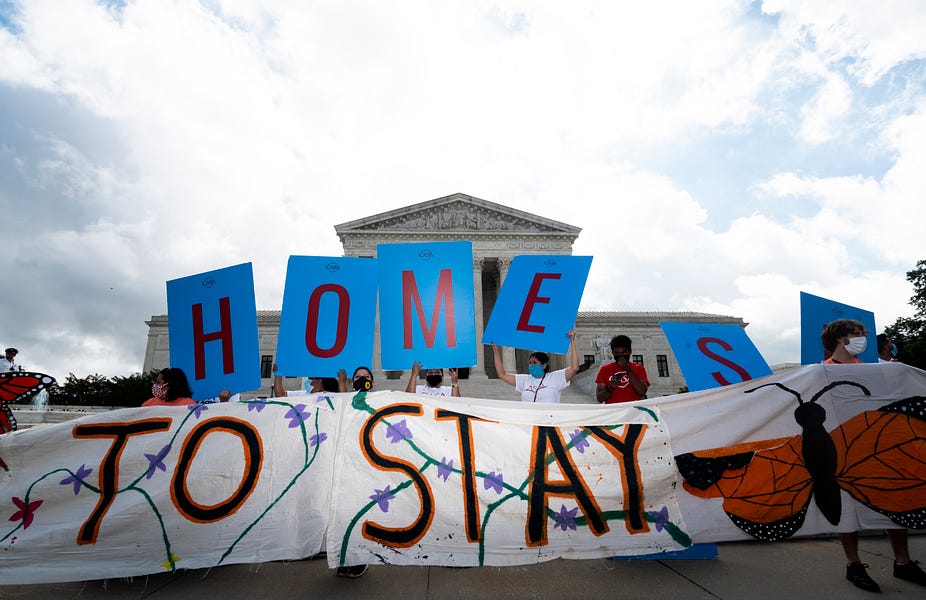Never let it be said that the Supreme Court lacks a flair for the dramatic. Just three days after a series of rulings and orders that led me to ask whether America witnessed “a conservative legal Chernobyl,” SCOTUS dropped another momentous ruling. This time, it defied the Trump administration and saved (for now, at least) the Obama administration immigration program called Deferred Action for Childhood Arrival, better known as DACA. Justice Roberts joined the four Democratic nominees to write the majority opinion in the case, called Department of Homeland Security v. Regents of the University of California.
Reading the case, the legal analyst in me was surprised and disappointed. The litigator in me, however, immediately recognized a possible reason for Roberts’s ruling. The opinion, in my view, contradicts the law (and is inconsistent with the chief justice’s own jurisprudence). The actual outcome, interestingly enough, might be better explained by a Trump tweet:
I’ll explain in a moment. But first, the analysis. The short version of what happened is this—the Obama administration enacted a substantive change in immigration law through a memorandum that defied immigration statutes and the Administrative Procedure Act, a statute that requires the executive branch to go through a specific rulemaking process before enacting substantive regulations.
The DACA program did two things—first, it exercised “prosecutorial discretion” to permit illegal immigrants who arrived in the United States as children to receive a two-year forbearance of removal. Second, those granted forbearance then became eligible for “work authorization and other federal benefits.”
The second element of the program made DACA quite different from a simple exercise of prosecutorial discretion. It would be entirely proper for an administration to use its limited resources to prioritize for deportation other unlawful immigrants—for example, illegal immigrants who commit additional crimes in the United States (beyond unlawful entry). But as Justice Roberts noted, “the DACA Memorandum does not announce a passive non-enforcement policy; it created a program for conferring affirmative immigration relief.”
But here’s where the opinion goes off the rails. The majority did not hold that DACA is lawful. It did not hold that the Trump administration can’t revoke DACA. Instead, it held that the Trump administration’s explanation and justification for revoking the policy was legally incomplete.
What was that explanation? DHS’s initial September 5, 2017, decision to rescind the program was based on a September 4, 2017 memorandum from then-Attorney General Jeff Sessions.
The Sessions memo was indeed quite short. In fact, the core reason for rescission was contained in a single paragraph. Here it is, in its entirety:
DACA was effectuated by the previous administration through executive action, without proper statutory authority and with no established end-date, after Congress’ repeated rejection of proposed legislation that would have accomplished a similar result. Such an open-ended circumvention of immigration laws was an unconstitutional exercise of authority by the Executive Branch. The related Deferred Action for Parents of Americans and Lawful Permanent Residents (DAPA) policy was enjoined on a nationwide basis in a decision affirmed by the Fifth Circuit on the basis of multiple legal grounds and then by the Supreme Court by an equally divided vote. See Texas v. United States, 86 F. Supp. 3d 591, 669-70 (S.D. Tex.), aff’d, 809 F.3d 134, 171-86 (5th Cir. 2015), aff’d by equally divided Court, 136 S. Ct. 2271 (2016). Then Secretary of Homeland Security John Kelly rescinded the DAPA policy in June. Because the DACA policy has the same legal and constitutional defects that the courts recognized as to DAPA, it is likely that potentially imminent litigation would yield similar results with respect to DACA.
Later, after federal district courts issued injunctions against the Trump administration’s rescission action, the administration amplified and extended its reasoning, but Roberts wasn’t having it. He called the newer, longer justification for rescission a “post hoc rationalization.” The rescission action would stand or fall on the Sessions memo, and the memo, said the court, simply wasn’t enough:
[T]he Attorney General neither addressed the forbearance policy at the heart of DACA nor compelled DHS to abandon that policy. Thus, removing benefits eligibility while continuing forbearance remained squarely within the discretion of Acting Secretary Duke, who was responsible for “[e]stablishing national immigration enforcement policies and priorities.” 116 Stat. 2178, 6 U. S. C. §202(5). But Duke’s memo offers no reason for terminating forbearance. She instead treated the Attorney General’s conclusion regarding the illegality of benefits as sufficient to rescind both benefits and forbearance, without explanation.
But wait. While the Sessions memo was certainly short, it referenced a Supreme Court ruling letting stand an injunction against DAPA, a quite similar Obama program that applied to parents of childhood arrivals. Put another way, Sessions cited the Supreme Court, and Roberts said, “Not enough. Go back to the drawing board.”
So, at the end of the day, an Obama policy announced by a short memorandum could not be withdrawn by a memorandum—unless that memorandum was more detailed.
If you’re stumped by the legality of all this, you’re not alone. Here’s Justice Clarence Thomas:
DHS created DACA during the Obama administration without any statutory authorization and without going through the requisite rulemaking process. As a result, the program was unlawful from its inception. The majority does not even attempt to explain why a court has the authority to scrutinize an agency’s policy reasons for rescinding an unlawful program under the arbitrary and capricious microscope. The decision to countermand an unlawful agency action is clearly reasonable. So long as the agency’s determination of illegality is sound, our review should be at an end.
He’s correct. And so is Justice Samuel Alito. “What this means,” says Justice Alito, “is that the Federal Judiciary, without holding that DACA cannot be rescinded, has prevented that from occurring during an entire Presidential term. Our constitutional system is not supposed to work that way.” No, it is not.
That’s the legal analysis. What’s the litigator’s analysis? It seems that Justice Roberts has soured on the administration’s legal tactics and legal practice. This is more than just rank speculation. There’s evidence. Let’s consider three contentious Trump cases—the travel ban litigation, the census litigation, and DACA.
The first two cases were marked by sloppy and sometimes deceptive execution. Don’t forget that the travel ban went through three different versions (and considerable chaos) before the Supreme Court reached a final ruling in the case. Writing for the 5-4 majority upholding the travel ban, Justice Roberts held that the applicable statute gave the president an immense amount of discretion. Indeed, he wrote that the statute “exudes deference to the President in every clause.”
The chaos didn’t matter. Trump’s comments indicating anti-Muslim animus didn’t matter. The statute controlled.
Fast-forward exactly one year and one day to the census decision. The question was whether the Trump administration could add a citizenship question to the 2020 census form. The applicable statutes granted the administration broad discretion (not quite as broad as in the travel ban case, but still quite broad), yet this time Roberts ruled against Trump—holding that while a citizenship question isn’t “substantively invalid,” the administration’s explanation for adding the question didn’t add up. It made its decision, then went hunting for a reason. Here was Roberts:
The record shows that the Secretary began taking steps to reinstate a citizenship question about a week into his tenure, but it contains no hint that he was considering VRA [Voting Rights Act] enforcement in connection with that project. The Secretary’s Director of Policy did not know why the Secretary wished to reinstate the question, but saw it as his task to “find the best rationale.”
The record is not so stark in the DACA case, but it is telling indeed that Roberts repeatedly emphasizes that DHS’s second explanation for rescission as a “post hoc rationalization.” It’s as if he’s accusing the administration of shooting first and aiming later.
Why do I call this the litigator’s explanation? Because good litigators know that chaos loses cases. When judges sniff out incompetence or disingenuousness, they view your case with skepticism and are less likely to rule in your favor. That’s not always right, and sometimes it results in rulings that defy the law (such as the ruling in the DACA case), but it’s why the best lawyers take such great care to always appear to be the most reasonable party before the court.
It’s important to note that in both the census case and DACA, Roberts did not rule on the underlying merits of the administration’s position. In both cases, he functionally said, “Go back and do a better job.”
Moreover, I’m not the onlyperson to reach this conclusion. Roberts is often described as an institutionalist. I think that’s a fair description of an aspect of his jurisprudence. A true institutionalist attempts to safeguard not just his own institution but also the broader institutions of American government. It’s quite possible that Roberts has surveyed the Trump administration and declared, “This is not how you practice administrative law.”
But that’s a conclusion that also applies to the Obama administration. It fired the first sloppy shot with its own brief memorandum that not only violated the APA, it upset an entire complex congressional statutory scheme. Regardless of what one thinks of the underlying policy (and I generally support permitting childhood arrivals to stay in the United States), the Obama administration’s action was unlawful.
While one might prefer that the Trump administration revoked Obama’s memorandum with a DoJ document that was a legal and policy masterpiece, there is no such statutory requirement. Attorney General Sessions’s single page—referencing key court precedents—was quite enough. The chief justice made a mistake.
One last thing …
After my last newsletter, I must confess that I’m shocked and alarmed that so many of our otherwise-sophisticated Dispatch members have insufficient appreciation for a great American genius. I’ll never forget that moment, years ago, when Will Ferrell burst into our national consciousness. If you mock Ferrell, you mock this:
Photo By Bill Clark/CQ-Roll Call, Inc via Getty Images.







Please note that we at The Dispatch hold ourselves, our work, and our commenters to a higher standard than other places on the internet. We welcome comments that foster genuine debate or discussion—including comments critical of us or our work—but responses that include ad hominem attacks on fellow Dispatch members or are intended to stoke fear and anger may be moderated.
With your membership, you only have the ability to comment on The Morning Dispatch articles. Consider upgrading to join the conversation everywhere.